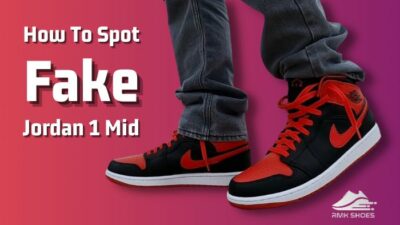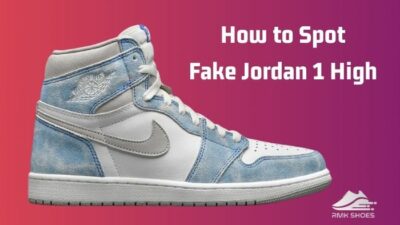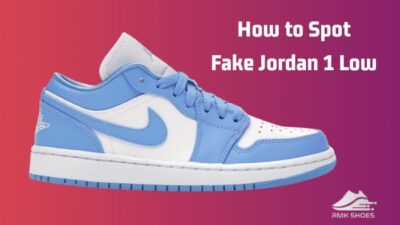As a parent, it’s important to make sure your toddler’s shoes fit properly. Because other than temporary discomfort, wearing an ill-fitted pair of shoes as a child can cause major podiatry problems in the long run.

But, can you even tell whether your toddler’s shoes are wrong-sized or not?
No worries! Stay put with this article, as I’ve disclosed the ways to tell whether your toddler’s shoes are fitting too small.
So, read on and get the perfect-sized shoes for your toddlers!
How To Tell If Toddler Shoes Are Too Small?
You can tell when your toddler’s shoes are too small for their tiny feet by looking for some signs. For instance, your toddler’s shoes are small if, they are tightly pressing their skin while causing blisters or if there’s no gap between their toe and the shoe front.
Furthermore, you should carefully look for a few obvious signs telling that your child’s shoes are too tight.
So, let’s find out, how can you tell when your toddler’s shoes are too small for them.
1. Shoes are Difficult to Put On or Take Off
If you’re having a hard time getting your child’s shoes on or off, it may be because they’re too small. This is the easiest way to find out when your kiddo’s shoes are wrong-sized. Because shoes that fit properly should be easy to slip on and off without a struggle.
2. Toes are Scrunched Up
Also, while taking off your child’s shoes, if their toes are scrunched up or curled, it’s a good indication that the shoes are too small. But their toes should not touch the end of the shoes.
This is a good way to find out if the shoes are fitting tight or not. Because children’s toes should have enough space to wiggle around comfortably inside their shoes.
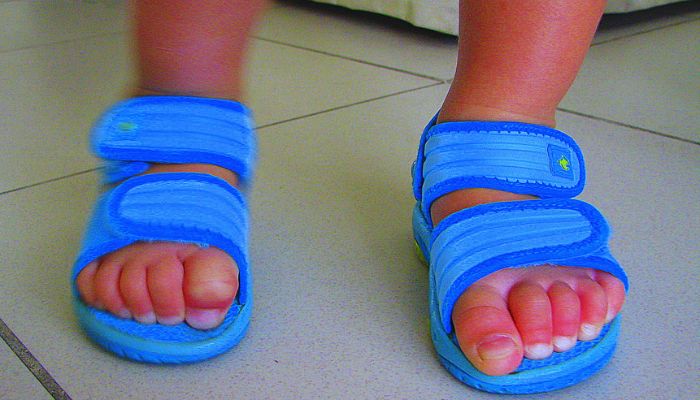
3. Your Child Complains of Discomfort or Pain
After wearing the shoes, if your child is complaining of pain in their feet or toes, then the shoes are too small.
But what to do when your toddler can’t talk? Well, in that case, look for their walking pattern. If you find them struggling to walk on their shoes or frequently tripping over, then it may be due to the too-small shoes.
4. Shoes Leave Red Marks or Blisters on the Feet
Red marks or blisters are caused when the shoes put too much pressure on the foot’s skin. Hence, looking for red marks or indents is a good way to find out wrong-fitted shoes.
So, take a look at your child’s feet after they’ve been wearing their shoes for a while. If you notice any red marks or blisters on their feet and any damage to their nails, it may be because the shoes are too tight.
5. The Feet Look Small
Too tight shoes can make your child’s feet look smaller than usual, as their toes will be curled. So, look at your standing toddler’s shoes, if their feet look smaller, chances are the shoes are fitting too tight. Also, for low-cut shoes, you will find portions of your child’s feet bulging out if the shoes are too small.
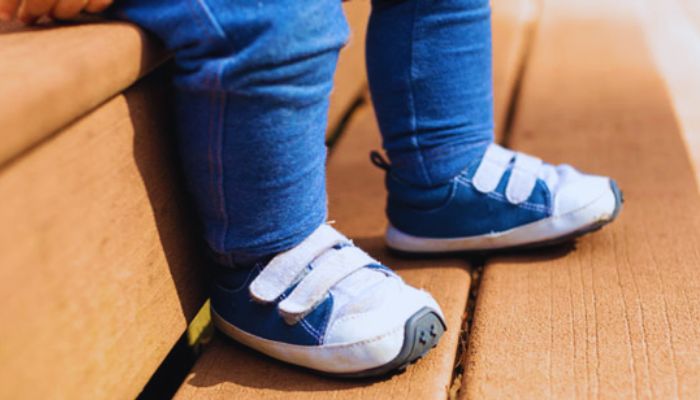
6. Uneven Shoe Wear
Shoes that are too tiny can cause your child to walk differently, leading to uneven wear on the soles of the shoes. So, if you notice that your toddler’s shoes are wearing out unevenly, it says the shoes are too small.
Moreover, if you notice any of these signs, it’s important to take action and get your child properly fitted with new shoes.
What Happens If Kids Wear Shoes Too Small?
It’s normal to find your toddler’s feet getting bigger at a remarkable rate. Within a few months, you’ll notice that their tiny little feet are outgrowing their shoes. This is because they are at a developing age, which determines how firm and healthy our bodies in the future will be.
But proper development of your kid’s feet requires a friendly environment as well. Wearing shoes too small for a long time can even cause damage or deformity to their feet.
So, let’s find out what happens when your child wears shoes that are too small.
- A tight-fitted pair of shoes can cause irritation, bruises, and even blisters to your child’s feet.
- Other than temporary problems like blisters, long-term wear of tight shoes can hinder your toddler’s foot development. And they may face many physical issues later in their life. Also, a tight pair of shoes can cause ankle pain that can be severe over time.
- Wearing small shoes for a long time can cause feet deformities like ingrown toenails, bunions, and hammertoes.
- While reducing their mobility, too-small shoes can make your child frequently trip over. Even many kids can become less stable on their feet while losing their foot function.
- In extreme cases, this can cause diseases like Arthritis and Neuropathy.
Now that you know what awaits your toddler’s feet if they keep wearing ill-fitted shoes. But, on the other side, perfectly fitted shoes can ensure the proper growth of your toddler’s feet.
So, make sure that the shoes you are putting on your toddler’s feet are not too small for them.
How to Tell If Toddler Shoes Fit?
That said before, it’s extremely important to get the right fitted shoes for your toddlers, as ill-fitted shoes can lead to foot problems down the line. Only with the right shoes, your child will be able to play and explore to their heart’s content.
But while buying shoes for your child, you may struggle to find out if they are the perfect fit or not.
Worry not, as by following the below techniques, you’ll know if your toddler’s shoes are fitting right.
- After putting the shoes on your toddler’s feet, check the heel’s grip. To do that, gently pull down the ankle of the shoes a couple of times. The shoes should give a good grip to the heel while not being too tight.

- The toes of your child’s feet should not touch the front of the shoes. Press your finger at the very front of the shoe and check that the toes are not pressing against the shoe wall.
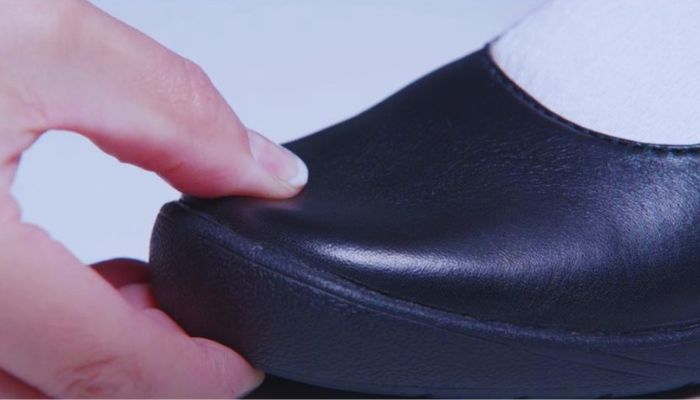
- To check if the width of the shoes is perfect or not, feel both sides of the shoes. You shouldn’t feel any pressure on the sides.
- Gently rub your finger throughout the upper of the shoes. There shouldn’t be any pressure against the shoe’s wall, which means they are not too tight.

But to make sure the shoes are not too wide, there shouldn’t be a big gap beneath either.
- Finally, make your toddler walk in the shoes with socks on. They shouldn’t feel any discomfort while walking. Also, the shoes should wrap the heels snugly, without too much gap around the sides.
However, make sure to measure the shoe size of your toddlers at weekly intervals, as their shoes get bigger at a remarkable rate. And by following these techniques, you can ensure the right fit of your kiddo’s shoes without any hassle.
FAQs
Should You Size Up in Toddler Shoes?
No, you shouldn’t size up in your toddler’s shoes unless they are too tight for them. Because going up with your toddler’s true size can cause discomfort while walking on and can also be unsafe for them. So, when buying shoes for your little ones, go with the size that fits well.
How Much Room Should a Toddler Have in Their Shoes?
In the length, there should be a gap of about 1 to 2 centimeters between the longest toe and the very front of the shoes. But the gap shouldn’t be less than 1 cm which will be smaller or more than 3 cm which will be bigger. Also, they should be able to wiggle their toes freely.
Parting Thoughts
It’s crucial to measure your toddler’s feet regularly and choose shoes that fit properly and comfortably. And for that, you should avoid shoes that are too little for their tiny feet.
However, I hope this article will help you find out the perfect fit for your precious children.
Plus, drop a comment down below for any further queries!

